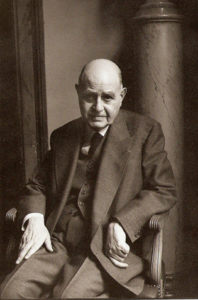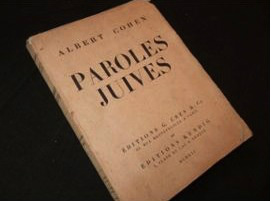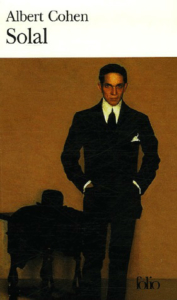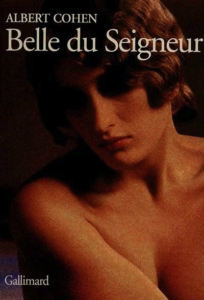Albert COHEN (1895-1981)
Swiss poet, writer, playwright in French originally from Greece.
 « They took the funicular, the cable car not having pleased them (What the hell, if at least we had put a large net under the car as for the acrobats of the Circus O follies and Christian imprudence) but once the little train started moving, they shivered at the thought that the funicular’s teeth might snap. So they got off at Monnetier.
« They took the funicular, the cable car not having pleased them (What the hell, if at least we had put a large net under the car as for the acrobats of the Circus O follies and Christian imprudence) but once the little train started moving, they shivered at the thought that the funicular’s teeth might snap. So they got off at Monnetier.
They initially thought about hiring donkeys to take them to the top, but they very quickly changed their minds. In short, Monnetier was eight hundred meters above sea level. That was quite enough. It would be at least to pay for a journey of four thousand meters in Cephalonia. »
This extract from »Mangeclous » (Nailcruncher) published in 1938 reminds us that the Swiss writer Albert Coen (he will add the « h » to his surname later) settled in Geneva since the age of 17 inspired by our region.
 Albert COHEN was born in Corfu, Greece, on August 16, 1895. He comes from a family of soap manufacturers – members of the Ottoman island’s important Sephardic community. Around 1900, Albert’s parents settled in Marseille and opened a business selling eggs and olive oil. First Albert studied at a private Catholic school, and then entered Thiers High School where he met Marcel Pagnol – a classmate whom he befriended. In 1913, he obtained his bachelor’s degree with the mention ‘’pretty good’’.
Albert COHEN was born in Corfu, Greece, on August 16, 1895. He comes from a family of soap manufacturers – members of the Ottoman island’s important Sephardic community. Around 1900, Albert’s parents settled in Marseille and opened a business selling eggs and olive oil. First Albert studied at a private Catholic school, and then entered Thiers High School where he met Marcel Pagnol – a classmate whom he befriended. In 1913, he obtained his bachelor’s degree with the mention ‘’pretty good’’.
The following year, Albert Cohen moved to Geneva and enrolled in the Faculty of Law. He obtained his license in 1917, and then enrolled in the Faculty of Letters. In 1919, he obtained Swiss nationality and married Elisabeth Brocher who gave him a daughter – Myriam – born in 1921. It was during that time that he published his first collection of verses Paroles Juives (Jewish Words)
 Albert Cohen diplomat at the I.L.O. International Labor Office and S.D.N. the League of Nations:
Albert Cohen diplomat at the I.L.O. International Labor Office and S.D.N. the League of Nations:
In 1924, he took charge of the Revue Juive and at the same time began a diplomatic career as a delegate of the Zionist movement to the S.D.N., then as an official at the B.I.T. where he created « the passport for refugees and stateless persons ». During that period, Albert Cohen met Jane Fillion, a young liberated woman, living in the family home in Pinchat. According to the French writer Nathalie de Saint Phalle, she would become Ariane, the heroine of the future novel: « Belle du Seigneur ».
In 1930, he wrote his famous novel – Solal (Solal of the Solals) – which was followed by Mangeclous in 1938. In the meantime, he became a member of the Sephardic Brotherhood Group in Geneva and married for the second time to Marianne Goss.
 On the way to the coronation: Belle du Seigneur
On the way to the coronation: Belle du Seigneur
At the time of the German invasion in May 1940, Albert fled to Bordeaux and then to London where he met General De Gaulle. Then the Jewish Agency for Palestine nominated him to establish contacts with the governments in exile.
In 1943, he met his future third wife, Bella (Beila) Berkowich. The following year, he became legal adviser to the Intergovernmental Committee for Refugees. In 1947, Cohen returned to Geneva and, in 1954, he published Livre de ma Mère (the Book of my Mother), in which he recounted his youth.
The year 1968 was his coronation when he published his major work – Belle du Seigneur – which received the Grand Prix of the French Academy. In 1970, he was made Knight of the Legion of Honor. In 1972, he published ô vous frères humains (O you, human brothers).

Albert and Bella Cohen. Photo: © Marc Riboud – 1979
The Notebooks of a Genius:
While Albert Cohen was at the height of his genius, he suffered a nervous breakdown and nearly died of anorexia in 1978. He then radically changed his life and used the last years of his life to do whatever his friend Pagnol had done all his life: promoted his work. Coming out of asceticism, he published his Notebooks in 1978 followed by responses to numerous requests for interviews. It is then that the general public started to appreciate him. He published his last text in the Nouvel Observateur in May 1981.
He died on October 17, 1981. He was buried in the Israelite cemetery of Veyrier.
The article is written and presented by Christiane DUTOIT, member of La Mémoire de Veyrier. Original article in french (with their kind autorization).
© La Mémoire de Veyrier 2017, www.la-memoire-de-veyrier.ch
Kind translation by Marina KREYMERZAK, member of Patrimoine juif genevois.
© Marina Kreymerzak/Patrimoine juif genevois 2021


